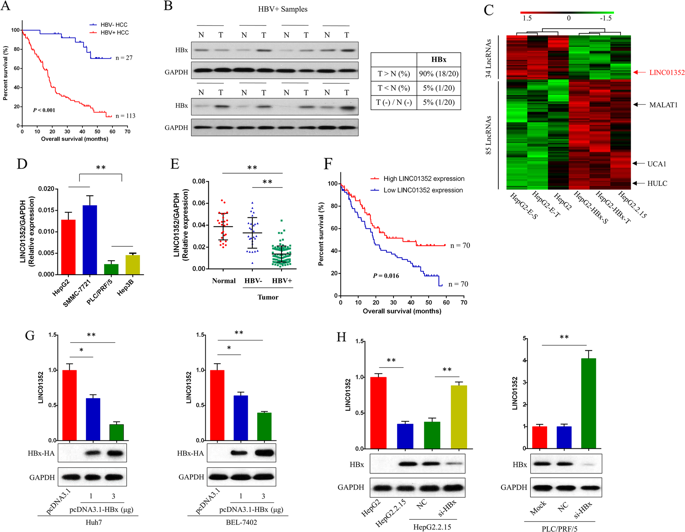Our official English website, www.x-mol.net, welcomes your
feedback! (Note: you will need to create a separate account there.)
HBx/ERα complex-mediated LINC01352 downregulation promotes HBV-related hepatocellular carcinoma via the miR-135b-APC axis.
Oncogene ( IF 6.9 ) Pub Date : 2020-03-10 , DOI: 10.1038/s41388-020-1254-z Pinbo Huang 1, 2 , Qiaodong Xu 3 , Yongcong Yan 1, 2 , Yingjuan Lu 4 , Zhigang Hu 1, 2 , Bing Ou 5 , Heyun Zhang 1 , Kai Mao 1 , Jianlong Zhang 1 , Jie Wang 1 , Zhiyu Xiao 1, 2
Oncogene ( IF 6.9 ) Pub Date : 2020-03-10 , DOI: 10.1038/s41388-020-1254-z Pinbo Huang 1, 2 , Qiaodong Xu 3 , Yongcong Yan 1, 2 , Yingjuan Lu 4 , Zhigang Hu 1, 2 , Bing Ou 5 , Heyun Zhang 1 , Kai Mao 1 , Jianlong Zhang 1 , Jie Wang 1 , Zhiyu Xiao 1, 2
Affiliation

|
Hepatitis B virus (HBV) infection plays an important role in hepatocarcinogenesis, especially in hepatocellular carcinoma (HCC). Long non-coding RNAs (lncRNAs) have emerged as crucial biomarkers and regulators in many cancers. Novel lncRNAs involved in the initiation and progression of HBV-related hepatocellular carcinoma (HCC) need to be investigated. Here, we report that the long non-coding RNA LINC01352 is markedly downregulated by HBV/HBx (HBV X protein) in HCC cells and clinical samples. The LINC01352 expression level in HCC is an independent prognostic factor for survival. We found that HBx suppresses LINC01352 promoter activity by forming a complex with the estrogen receptor (ERα). Furthermore, using a combination of in vitro and in vivo studies, we confirmed that HBx promotes HCC cell growth and metastasis by inhibiting LINC01352 expression. Further investigation revealed that the downregulation of LINC01352, which acts as an endogenous sponge, increases the expression of miR-135b, leading to the reduced production of adenomatous polyposis coli (APC), consequently activating Wnt/β-catenin signalling to facilitate tumour progression. These findings strongly suggest that the LINC01352-miR-135b-APC axis regulated by the HBx/ERα complex acts as an important pathogenic factor for tumour progression, which may help provide a theoretical basis for the identification of new therapeutic targets for HBV-related HCC.
中文翻译:

HBx/ERα 复合物介导的 LINC01352 下调通过 miR-135b-APC 轴促进 HBV 相关的肝细胞癌。
乙型肝炎病毒(HBV)感染在肝癌发生中起重要作用,特别是在肝细胞癌(HCC)中。长非编码 RNA (lncRNA) 已成为许多癌症的重要生物标志物和调节因子。需要研究参与 HBV 相关肝细胞癌 (HCC) 发生和进展的新型 lncRNA。在这里,我们报道了 HCC 细胞和临床样本中的 HBV/HBx(HBV X 蛋白)显着下调长非编码 RNA LINC01352。HCC 中的 LINC01352 表达水平是生存的独立预后因素。我们发现 HBx 通过与雌激素受体 (ERα) 形成复合物来抑制 LINC01352 启动子活性。此外,结合体外和体内研究,我们证实HBx通过抑制LINC01352表达促进HCC细胞生长和转移。进一步研究表明,作为内源性海绵的LINC01352的下调会增加miR-135b的表达,导致腺瘤性息肉病大肠杆菌(APC)的产生减少,从而激活Wnt/β-连环蛋白信号传导以促进肿瘤进展。这些发现强烈表明HBx/ERα复合物调控的LINC01352-miR-135b-APC轴是肿瘤进展的重要致病因素,这可能有助于为HBV相关HCC新治疗靶点的鉴定提供理论基础。 。导致腺瘤性息肉病大肠杆菌 (APC) 的产生减少,从而激活 Wnt/β-连环蛋白信号传导以促进肿瘤进展。这些发现强烈表明HBx/ERα复合物调控的LINC01352-miR-135b-APC轴是肿瘤进展的重要致病因素,这可能有助于为HBV相关HCC新治疗靶点的鉴定提供理论基础。 。导致腺瘤性息肉病大肠杆菌 (APC) 的产生减少,从而激活 Wnt/β-连环蛋白信号传导以促进肿瘤进展。这些发现强烈表明HBx/ERα复合物调控的LINC01352-miR-135b-APC轴是肿瘤进展的重要致病因素,这可能有助于为HBV相关HCC新治疗靶点的鉴定提供理论基础。 。
更新日期:2020-03-10
中文翻译:

HBx/ERα 复合物介导的 LINC01352 下调通过 miR-135b-APC 轴促进 HBV 相关的肝细胞癌。
乙型肝炎病毒(HBV)感染在肝癌发生中起重要作用,特别是在肝细胞癌(HCC)中。长非编码 RNA (lncRNA) 已成为许多癌症的重要生物标志物和调节因子。需要研究参与 HBV 相关肝细胞癌 (HCC) 发生和进展的新型 lncRNA。在这里,我们报道了 HCC 细胞和临床样本中的 HBV/HBx(HBV X 蛋白)显着下调长非编码 RNA LINC01352。HCC 中的 LINC01352 表达水平是生存的独立预后因素。我们发现 HBx 通过与雌激素受体 (ERα) 形成复合物来抑制 LINC01352 启动子活性。此外,结合体外和体内研究,我们证实HBx通过抑制LINC01352表达促进HCC细胞生长和转移。进一步研究表明,作为内源性海绵的LINC01352的下调会增加miR-135b的表达,导致腺瘤性息肉病大肠杆菌(APC)的产生减少,从而激活Wnt/β-连环蛋白信号传导以促进肿瘤进展。这些发现强烈表明HBx/ERα复合物调控的LINC01352-miR-135b-APC轴是肿瘤进展的重要致病因素,这可能有助于为HBV相关HCC新治疗靶点的鉴定提供理论基础。 。导致腺瘤性息肉病大肠杆菌 (APC) 的产生减少,从而激活 Wnt/β-连环蛋白信号传导以促进肿瘤进展。这些发现强烈表明HBx/ERα复合物调控的LINC01352-miR-135b-APC轴是肿瘤进展的重要致病因素,这可能有助于为HBV相关HCC新治疗靶点的鉴定提供理论基础。 。导致腺瘤性息肉病大肠杆菌 (APC) 的产生减少,从而激活 Wnt/β-连环蛋白信号传导以促进肿瘤进展。这些发现强烈表明HBx/ERα复合物调控的LINC01352-miR-135b-APC轴是肿瘤进展的重要致病因素,这可能有助于为HBV相关HCC新治疗靶点的鉴定提供理论基础。 。










































 京公网安备 11010802027423号
京公网安备 11010802027423号